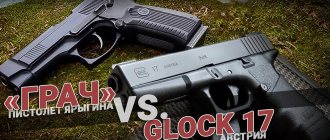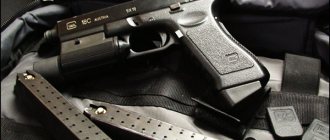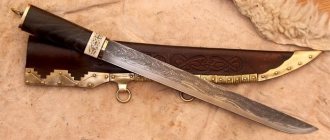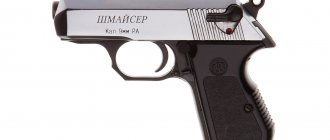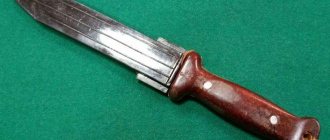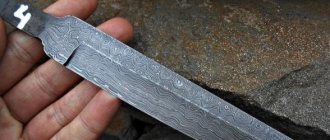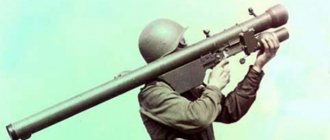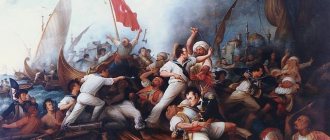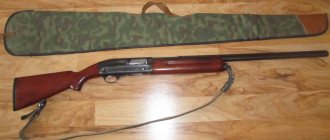Each blade has its own history of appearance. The Katran knife appeared during some of the most difficult days for the country of the USSR. Perestroika times had a bad impact on all industries. Including knife production sites. But the blade was able to stay afloat, literally and figuratively. Structurally, it was intended for combat swimmers.
Knife "Katran".
History of creation
Back in the Soviet Union, there was an urgent need to replace the universal diving knife (NVU). The reason was simple: it was very outdated and could not perform modern functions of that time.
And the initial production (NVU) did not provide for its use by combat swimmers. And it had many disadvantages:
- the steel from which the blade was made quickly became dull;
- the plastic handle was poorly held in the hand in an aquatic environment;
- the blade was polished and gave off reflections;
- the notch for breaking the wire weakened the entire wedge.
Knife "NVU" Soviet model.
The designers of that time were given the task of developing a blade that satisfied certain conditions. At the height of perestroika in the late 80s, the development of the katran combat knife began.
It initially contained three main functions. It was supposed to help a person survive, be the main tool of a diver, and, of course, have all the qualities of a military weapon.
About the difficulties of release
From a design point of view, it was perfectly balanced and had all the functionality that was required. Several samples were produced, but the blade never went into mass production. Severe cuts to the navy budget had an impact.
But it so happened that the initial design idea had to be abandoned; the knife retained only the shape of the handle. But if this had not been done, he could have left “life” altogether.
Improving the design
Just before its launch into production, well-known events took place regarding the collapse of the Union. But “fate smiled” on the developers and the knife itself; FSB officers became interested in it. The Bowie-style blade caught their attention.
Similar in shape to Bowie.
But the gentlemen from the FSB requested their design features and pledged to purchase 3,000 copies. The Tula Arms Plant had to change it a little for land use. And it received the name “Katran-1C”. Where the letter “C” meant land.
Some changes were made, but the knife did not lose the recognizable saw on the blade closer to the butt. The design was changed from this perspective:
- leather sheath with built-in metal holder;
- the handle became wooden, or more specifically walnut;
- camouflage cover;
- The lid of the pencil case for NAZ has become flat.
The knife gained popularity among employees of the FSB and the Ministry of Internal Affairs.
During the first armed conflict in Chechnya it became widely used. The saw that was on the butt helped inflict more severe wounds.
Good option
As experience in combat has shown, the presence of good bladed weapons in a soldier’s personal equipment plays a significant role. "Katran" turned out to be a good knife for close combat.
Rumor has it that doctors who saw the wounds inflicted by this blade suggested banning its use in warfare . And declare it an inhumane weapon.
Strange thinking about humanity, but this is their opinion. The option turned out to be quite successful, thanks to its main advantage. When removing it from the sheath, the shock teeth did not catch on them, and this is a problem with many blades.
After the end of the first Chechen war, the production of products was suspended for unknown reasons. But the knife was not forgotten and later he had “comrades in the shop” in the form of “Katran-2” and “Katran-3”. But more on that later.
Bayonet knives and combat knives of the post-war period
Already at the end of the 20th century, it became clear that the bayonet-knife was a rudimentary weapon, the practical meaning of which was lost almost one hundred percent. But despite all this, not a single army in the world dares to completely abandon it. Well, after all, the military has always been distinguished by a certain amount of conservatism. After arming most of the world's armies with automatic rifles (machine guns), the weight and size of the bayonet knife have decreased significantly. But he received additional devices (saws, wire cutters) - the designers tried to transform the bayonet-knife into a universal soldier’s tool.
Several versions of bayonet knives were made for the Russian AK assault rifle. He received the first of them exclusively in 1953. This bayonet did not have any additional devices; its blade was one hundred percent identical to the blade of the bayonet-knife for the SVT-40 rifle. The 1978 standard bayonet for the AK-74 assault rifle received a new shape, borrowed from a diving knife, a plastic handle and a saw on the butt. The knife together with the sheath can be used for cutting wire; for this purpose, a special hole was made on the blade.
Reviews about the bayonet for the AK-74 are often negative. Its handle is inconvenient, the saw is not enough to cut, and the blade is not enough to cut off. But mounted on the barrel of a machine gun, it performs its functions perfectly and can inflict the deepest wounds. The developers had to combine three functions into one weapon: a bayonet, a combat knife and a tool - the result could hardly have turned out flawless.
In 1989, another standard bayonet for the AK-74 and Nikonov assault rifle was adopted. It significantly corrects the main shortcomings of its predecessors. It received a different shape for the blade and handle, as well as the material from which the sheath and handle are made.
In 1964, the M7 Bayonet bayonet , intended primarily for inflicting damage on the enemy, and not for use as a tool. It had a symmetrical dagger blade with a one-and-a-half sharpening, about 170 mm long.
In 1984, the M7 Bayonet was replaced by a new bayonet - the Ontario M9 , which is basically an implement rather than a combat knife. It is successfully produced by several companies and has significant commercial success. This bayonet-knife has a blade of the classic American “Bowie” shape, there is a metal saw on the butt, and the upper part of the guard is used for attaching to the gun barrel. The handle has a spindle shape and is made of special plastic. Like the AK-74 bayonet, the M9, complete with a scabbard, can cut wire.
Design
Experimental options that appeared before the interest of special services. At that time they had an anti-reflective coating, and on the butt there were shock teeth of a rather unusual design. If you look closely, you can see rows of small teeth on them, which, according to the designers’ plans, should have cut any material.
A magnificent copy of "Katran".
The handle was made of corrugated rubber and hollow inside; the NAZ was supposed to be placed there in a sealed case. These first knives, which never went into mass production, retained the name “Katran-1”. It was difficult to classify them, since there was no numbering of the blades.
Design features
Description and features:
- the handle has transverse corrugation;
- there is a metal guard, that is, a hilt with a protrusion for the fingers, the guard is made in such a way as to provide a reliable grip with a hand wearing a thick diving glove;
- under the handle there is a steel case, hermetically sealed and including an emergency reserve;
- blade length is 180 millimeters;
- material – resistant steel;
- the surface of the blade is covered with a protective layer of black chrome;
- there is additional anti-glare protection;
- the sheath is made of leather;
- Inside the sheath there is a thin steel liner.
Characteristics
The very first katran knife, the production of which was never financed by the navy. Had the required characteristics:
- chrome anti-reflective blade coating;
- plastic sheath with the ability to be fixed anywhere on the body;
- wavy serrations acting as a saw
- total length 30.0 cm;
- blade length 18.0 cm;
- maximum blade width 3.7 cm;
- butt thickness 6 mm;
- handle length 13.5 cm;
- handle width (middle part) 3.6 cm;
- handle thickness (middle part) 2.5 cm;
- blade hardness, HRC 52-56;
- blade material: steel 50Х14МФ, 70Х16МФС (according to patent RU236957C1) - for the land version and 95Х18 - for the underwater version.
The next model “Katran-1S”, which was ordered by the FSB, was described above. More on other modifications a little later.
Combat knives of elite units of the Russian army
Military personnel sometimes joke that the best knife is a pistol . In fact, combat knives are a very special type of weapon, the ability to wield which is sometimes as necessary as shooting quickly and accurately to kill and having excellent physical fitness.
We present to you the best Russian combat knives - those that are in service and used by special forces, in the army or in law enforcement agencies.
The content of the article
Storm
Experimental model of a utility knife for the Marine Corps . The creation of universal knives has always attracted designers developing new models of edged weapons, but solving a wide range of problems with the help of one tool is almost impossible.
The Storm knife has a stainless steel blade and an impact-resistant, chemically inert handle, as a result of which it can be used for close combat by Marine Corps units, for which it was, in fact, developed. The knife is purely a combat one - due to the lack of a saw on the butt and a serrator on the blade, it can hardly be considered as a universal one.
Lynx
The knife was made by order of the Moscow SOBR from the city of Zlatoust. It exists in three versions - a combat knife , a premium combat knife and a civilian modification. The photo below shows the combat version. The award version differs in that it is made with gilding, but in terms of tactical and technical characteristics it does not differ from the combat version.
DV-1 and DV-2
The DV-1 and DV-2 knives, differing only in blade length, were developed to order and in collaboration with Far Eastern special forces . Their names indicate this - DV means “Far Eastern”. These are massive camping knives that can withstand heavy loads and can be used for the toughest jobs.
The photo above shows a DV-1 knife with a spear-shaped blade and additional sharpening on the spine. The handle of the knife is made of Caucasian walnut, the steel guard and pommel are made of the same material. The DV-1 knife has an all-metal tang that passes through the handle, a screw assembly and a leather sheath.
The photo shows an export version of the DV-2 knife from a limited edition, which differs from its serial progenitor in the materials used. Its blade is made of Z60 steel instead of the usual carbon steel 50Х14МФ for these knives, and the handle of the knife can be made of leather, whereas the basic version has only walnut. At first glance, the knife impresses with its size. Its total length is 365 mm, and the blade length is 235 mm. To protect against corrosion and prevent unmasking glare, a matte black coating is applied to the blade. Half-click releases, even with a solid thickness of 5.8 mm, provide a good cut. On the butt of the blade there is a section with a bevel, forming an unsharpened wedge, which is used for chopping bones. The notch in front of the guard (choil) allows you to intercept the knife by passing its guard between the index and middle fingers. Such a grip serves to make it easier to pull out a stuck knife, as well as for a number of jobs where such an arrangement of the hand on the knife provides better control.
DV-2 has a double-sided guard, which perfectly protects the hand. The handle, made of leather disks tightly fitted to each other, has an oval cross-section. The handle ends with a massive pommel, used for traumatic purposes. The pommel is put on a through shank and tightened on it with a flat nut. The knife sheath is of a classic design, made of two layers of thick leather, connected with rivets. The suspension is vertical, with a strap that securely fixes the handle.
chastener
The “Punisher” series knives are designed and manufactured for the security forces of the FSB of Russia, which has been producing high-quality knives since 1994, including a wide range of combat knives and daggers. “Punishers” are produced in two modifications – “ VZMAKH-1 ” and “ Maestro ”. In addition, there are modifications that differ in the material of the handle (stacked leather, rubber or kraton). " VZMAKH-1 " differs in the root part of the serrated sharpening, and "Maestro" - in the serrated sharpening at the top, the type of sheath and the type of finishing of the blade ( anti-reflective, black or camouflage ).
The guard is double-sided. The wide blade is convenient for digging and allows, if necessary, to use the knife as additional support on slopes with loose soil. The cutting part of the blade has a crescent-shaped cavity, which allows you to increase the length of the cutting edge while maintaining linear dimensions. The knife is equipped with a sheath made of high-quality leather or avisent, allowing it to be attached to the arm, leg, belt and elements of combat or hiking equipment. The " VZMAKH-1 " knife has been officially adopted for service.
Knight
NSN Knives “ Vityaz NSN ”, “ Vityaz NM ”, “ Vityaz ” were developed by order of the President of the Vityaz Design Bureau , Hero of Russia S.I. Lysyuk to equip special . A distinctive feature of the design is a large, heavy blade with a narrow blade, which makes it possible to maintain the inertia of movement upon impact, reduce weight and increase penetrating ability, and an anatomically comfortable guard that allows you to hold the knife in your hand while working.
Anti-terror
The Anti-Terror knife was designed and manufactured for the security forces of the Russian FSB. The knife blade has a petal shape, which allows maximum use of the working area of the blade and increases its cutting properties. The blade configuration has high penetrating abilities; the cutting part has a crescent-shaped cavity, which allows you to increase the length of the cutting edge while maintaining linear dimensions. The back of the blade has been strengthened. The standard ergonomic guard does not allow the hand to slip at the moment of striking.
Katran
Combat knives of the " Katran " series differ in the type of blade and handle material. Knives of the " Katran " series, depending on the modification, are used as an underwater knife, a combat knife or a survival knife. The knife handle has a double-sided guard and a metal pommel. Handle material: leather, rubber or kraton, depending on the modification. " Katran-1 " is an underwater combat knife. Blade with one and a half sharpening. The sharpening on the butt is made in the form of a wave-shaped saw. The root part has a hook for cutting nets and serrated sharpening. Rubber handle. Plastic sheath with straps for hanging on the leg. The coating of metal parts is black chrome.
" Katran-1-S " is a land version of this knife. Differs in blade material: steel 50Х14 MF. Anti-glare treatment of metal parts. The handle is made of leather. Leather sheath with plastic insert. " Katran-2 " is a hunting knife with one and a half sharpening. The sharpening point on the butt has an angle designed for chopping. Anti-glare treatment. The handle is made of leather. The scabbard is leather. " Katran-45 " - a combat knife . An exclusive model, developed by order of the 45th Airborne Regiment . It is distinguished by the presence of a metal saw blade on the butt and an anti-reflective coating. The handle is made of leather. Leather scabbard. There is an option with camouflage coating of metal parts.
Shaitan
The combat dagger " Shaitan " was developed in 2001 by order and together with employees of the law enforcement unit of the Ministry of Internal Affairs of the Republic of Tajikistan . The combat dagger “Shaitan” is available in two modifications: the handle is inlaid leather and the skeletal type (“ Shaitan-M ”). The knife has a narrow leaf-shaped blade with double-sided sharpening. In the root part the sharpening is serrated. The serrator is designed for use as a sling cutter and easily cuts 10-12 mm climbing rope. The shape of the blade is designed for inflicting deep cut wounds, as well as for maximum use of the working part of the blade. The guard and handle are made symmetrical. Also, " Shaitan-M " can be used as a throwing knife that can withstand up to 3000 throws. The handle is made of stacked leather, subjected to special treatment. All metal parts have anti-reflective treatment.
Akela
Akela knife was developed by order of SOBR as a “ police ” knife . A distinctive feature is its small size, which allows it to work in cramped urban environments, crowded places, and where application is impossible. The knife is a dagger type, double-edged, the blade has an anti-reflective coating (black chrome). The handle is made of MBS rubber and fits comfortably in the hand. The pommel is metal and has a hole for a lanyard.
Smersh-5
The Smersh-5 knife is a classic combat knife . The prototype of this knife was used during the Second World War (HP-43). The knife blade has high penetrating ability. The ergonomic guard does not allow the hand to slip during a strike. The upper butt part of the guard is designed for additional pressure when cutting hard objects.
Gyurza
The sample shown in the photo was adopted by special units of the FSB. The Gyurza knife consists of two modifications and has a narrow blade with a one-and-a-half sharpening. On the butt part of the sharpening is made with a serrator. The serrator increases the combat capabilities of the knife, and is also used for cutting ropes and cables and, to a limited extent, as a substitute for a saw.
Cobra
The combat knife " Cobra " was developed by order of the SOBR of the Ministry of Internal Affairs of the Russian Federation . This is a small dagger with a narrow blade and a double-sided, anatomically comfortable guard. " Cobra " is a serious weapon that allows you to solve combat missions in crowded places where the use of firearms . This dagger is designed not only for thrusting; the shape of its blade allows the use of cutting and chopping techniques, both with a direct and reverse grip.
Explosive technician
This large and powerful knife with a blade 180 mm long was developed by order of the FSB sapper units . “ Vzryvotekhnik ” was created as a universal knife designed to perform the functions of a combat weapon, a survival knife and an engineering tool. Currently officially accepted for supply. The blade is symmetrical, with differentiated sharpening - on one side of the blade there is a regular sharpening, on the other there is a fine serrated blade. The wooden handle has a steel pommel, which can be used both in combat and as a hammer.
Dagger of Russian Financial Intelligence
The combat knife shown in the photo, made by (Zlatoust), retains all the features of a classic dagger - a double-edged blade, symmetrical guard and handle. This dagger is interesting because it is, apparently, the only case in modern Russia of the revival of the tradition of departmental weapons, which, being a military model, at the same time indicates belonging to a strictly defined state structure. A small and only batch of this combat knife was manufactured in 2008 by order of the Financial Monitoring Service specifically for its employees. The dagger is made of stainless steel, the handle is made of leather, the guard and butt are aluminum.
OTs-4
The abbreviation “OTs” stands for “Weapon TsKIB”. The OTs-04 knife was developed at the Tula Central Design Research Bureau (TsKIB) in the late 80s - early 90s and was intended for special forces of the Ministry of Internal Affairs. The knife has a very massive design, the thickness of the butt is 7 mm. The blade has a slight bevel in the front. There is a double-row saw on the butt of the blade, but due to the low height of the teeth, its efficiency is relatively low, especially when sawing raw wood. The handle is symmetrical, with a double-sided guard, made of plastic and has large corrugations for better grip.
The scabbard is iron, riveted from two halves. In them, the blade is held by a spring-loaded plate, similar to AK bayonet knives. The sheath has a leather loop for the classic placement of the knife on the belt. Also included are adjustable leather straps that allow you to position the knife on your body and gear in multiple ways.
Source
Where is it used?
The main application of the katran knife was found in the land direction, although it was originally developed for sailors and marines. He never got to them. It was most widely used in the first Chechen operation.
Knife fighter training.
According to the stories, metal doors were opened for them. And one day they broke through a brick wall with these knives and escaped from heavy enemy fire. The strength of the katran can only be envied; it can withstand a fully equipped fighter.
The special forces soldiers who were leaving for civilian life did not want to give up this beautiful blade, and quite often they were cunning: they lost it, they stole it, etc.
This behavior speaks of a truly worthy knife, which it is a pity to part with. He found himself precisely in military operations.
Also, special units of the Ministry of Emergency Situations became interested in Katran knives. And there is reliable information that in the early 2000s they were used by employees of the Ministry of Internal Affairs and the FSB.
About the difficulties of release
At the very beginning, the Katran combat knife was produced in a limited edition. During its release, its design and appearance gradually changed. So, the very first metamorphosis touched the handle.
The handle for the knife ends in a conical element. Its use was that it made it possible to strike an enemy and injure him. This was necessary if the opponent needed to be neutralized, but left alive.
Modifications
After the end of hostilities, interest in the blade subsided, but not for long. It should be noted that in the name “Katran-1” there was no number “1”; this is, so to speak, “national numbering”. Perhaps, clinging to this fact, she began producing blades with the official name “Katran-2”. Several different modifications looked like this:
- the Katran-2 product turned out to be much simpler than its predecessors. The pencil case under the NAZ was removed, the guard was simplified, the serrator on the butt became simpler, the handle and blade were connected through a through installation. The scabbard was made only from leather. The handle was made of wood and kraton. By the way, this version of the handle made of the latest material was more suitable for submariners;
- a little later, the Katran-3 model was released, in which the serrator was completely removed, and in its place a second sharpened edge appeared. According to the developers, it was intended for logging. This modification was ordered by the 45th Airborne Regiment. And in some sources you can see the name “Katran-45”;
- Simplified models were also released for the population, the tip was beveled, and the thickness of the blade was less than that of combat versions. Later the bevel was modified to accommodate a screwdriver. But some “restless” citizens managed to regain the edge and then had problems with the law; Civil option.
- even later, different manufacturers produced folding knives and called them “Katran”, this is not true. Just a marketing ploy, the sonorous name began to be applied to different versions of tourist and fishing knives.
"Katran" from the company NOKS.
Keep in mind, a true combat knife is a katran, modifications “1,1C,2,3”. Everything else can safely be classified as fakes.
Advantages and disadvantages
All developers try to make the best knife possible. But, like any katran product, there are pros and cons. But without tips from true users, a manufacturer will never be able to make a knife with a minimum of flaws. Unfortunately, they will always be present. Same with the katran combat knife.
But given the fact that several variants of them were released, the advantages and disadvantages overlap in different variations. The main advantage of all knives can be called the specific shape of the blade. In “Katran-1C” and “Katran-2”, it coped with cutting reinforced cables and hoses, the width and method of sharpening the blade, as well as a high-quality wooden handle.
The second series and the third performed very well in the northern latitudes of the Russian Federation, although the models “1C, 2,3” had obvious disadvantages associated with corrosion. But we must take into account the fact that the blade, which was intended specifically for underwater fighters, never went into production.
And its design feature included anti-corrosion properties. Well, there’s one more controversial point about the handle, which many consider slippery, but let’s go back to the very first development, where the handle was made of corrugated rubber.
Previous
Combat knives Wehrmacht trench knife, M1918 and their modifications
Next
Combat knivesSKS bayonet - knife for Simonov self-loading carbine
